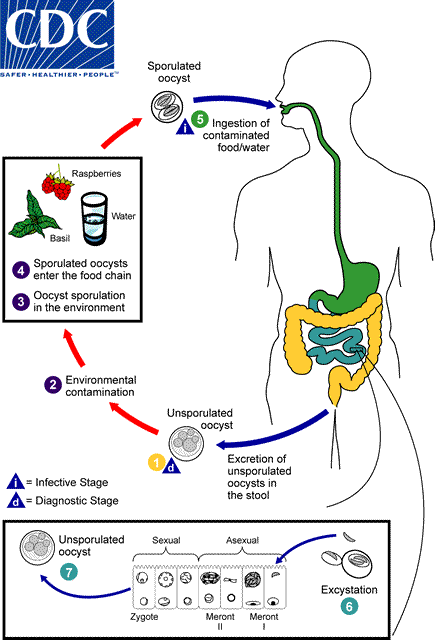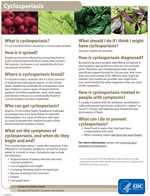Biology
Causal Agent:
Life Cycle:

Some of elements of this figure were created based on an illustration by Ortega et al. Cyclospora cayetanensis. In: Advances in Parasitology: opportunistic protozoa in humans. San Diego: Academic Press; 1998. p. 399-418.
When freshly passed in stools, the oocyst is not infective ![]() (thus, direct fecal-oral transmission cannot occur; this differentiates Cyclospora from another important coccidian parasite, Cryptosporidium). In the environment
(thus, direct fecal-oral transmission cannot occur; this differentiates Cyclospora from another important coccidian parasite, Cryptosporidium). In the environment ![]() , sporulation occurs after days or weeks at temperatures between 22°C to 32°C, resulting in division of the sporont into two sporocysts, each containing two elongate sporozoites
, sporulation occurs after days or weeks at temperatures between 22°C to 32°C, resulting in division of the sporont into two sporocysts, each containing two elongate sporozoites ![]() . Fresh produce and water can serve as vehicles for transmission
. Fresh produce and water can serve as vehicles for transmission ![]() and the sporulated oocysts are ingested (in contaminated food or water)
and the sporulated oocysts are ingested (in contaminated food or water) ![]() . The oocysts excyst in the gastrointestinal tract, freeing the sporozoites which invade the epithelial cells of the small intestine
. The oocysts excyst in the gastrointestinal tract, freeing the sporozoites which invade the epithelial cells of the small intestine ![]() . Inside the cells they undergo asexual multiplication and sexual development to mature into oocysts, which will be shed in stools
. Inside the cells they undergo asexual multiplication and sexual development to mature into oocysts, which will be shed in stools ![]() . The potential mechanisms of contamination of food and water are still under investigation.
. The potential mechanisms of contamination of food and water are still under investigation.
Life cycle image and information courtesy of DPDx.
- Page last reviewed: March 17, 2015
- Page last updated: March 17, 2015
- Content source:



 ShareCompartir
ShareCompartir